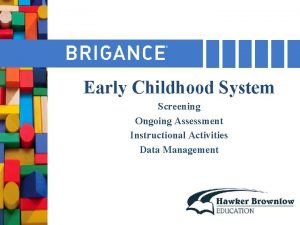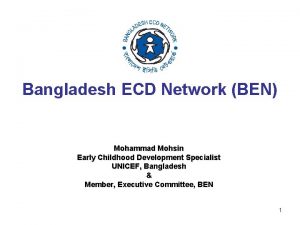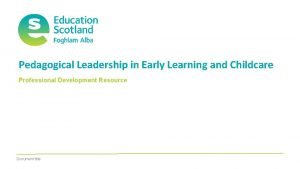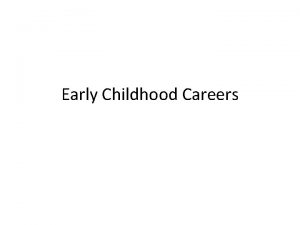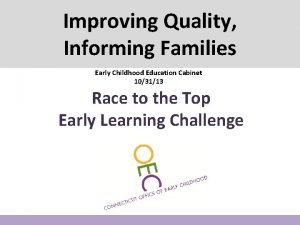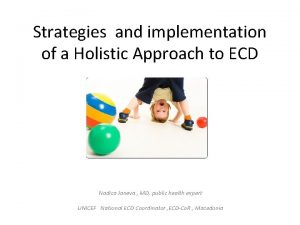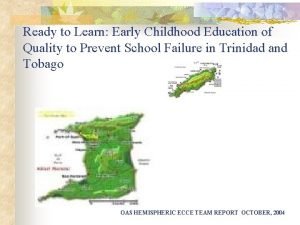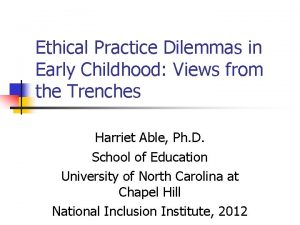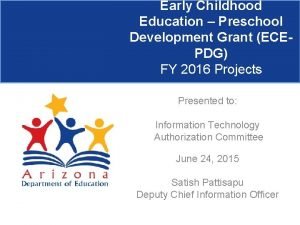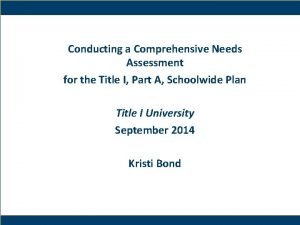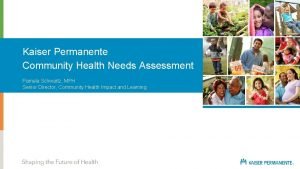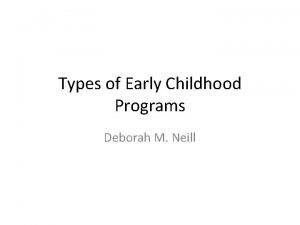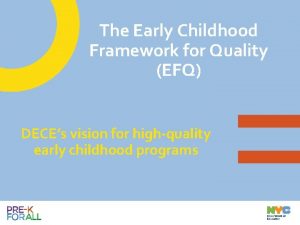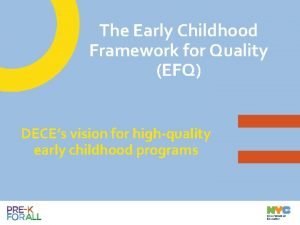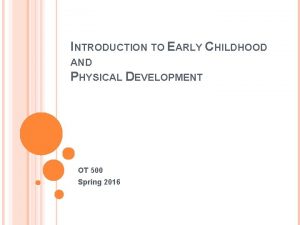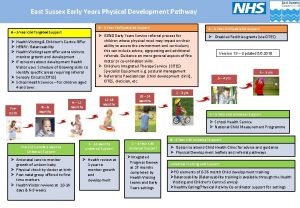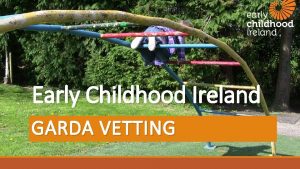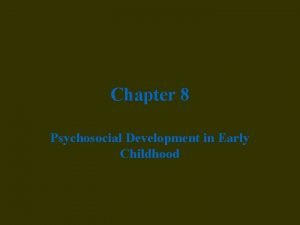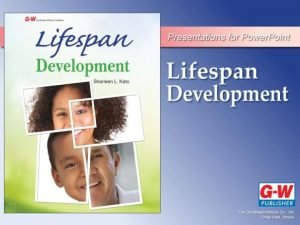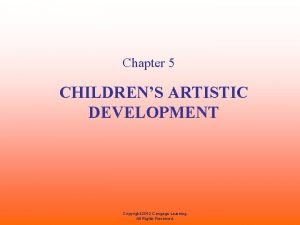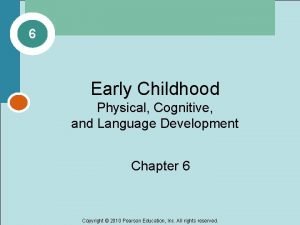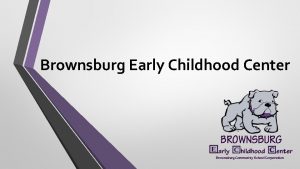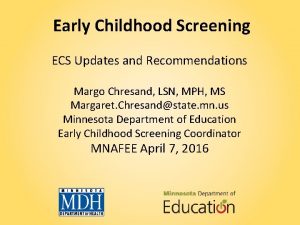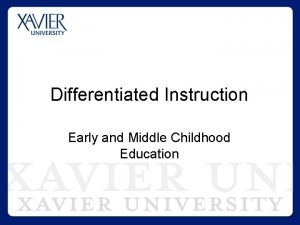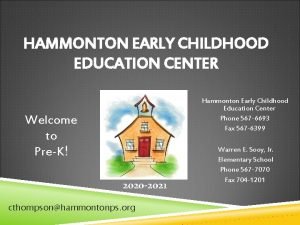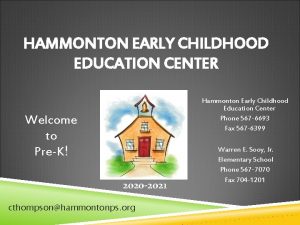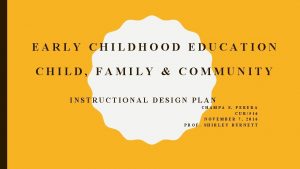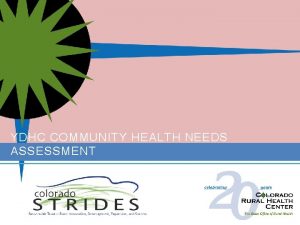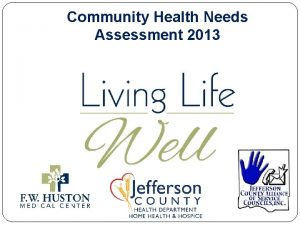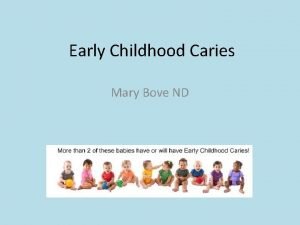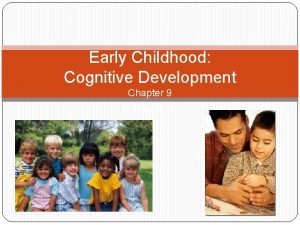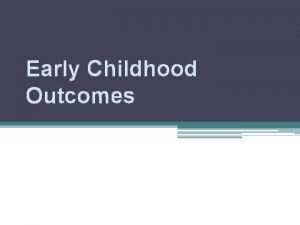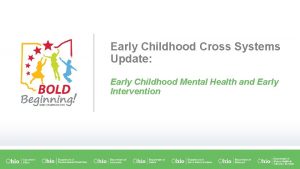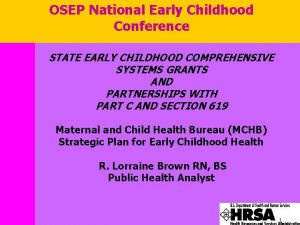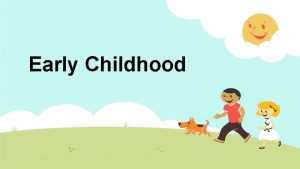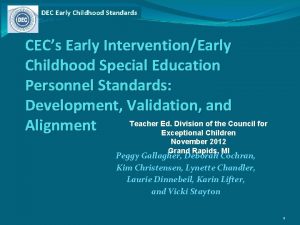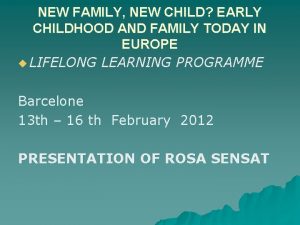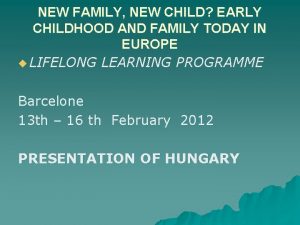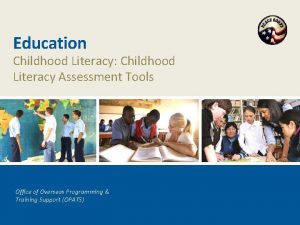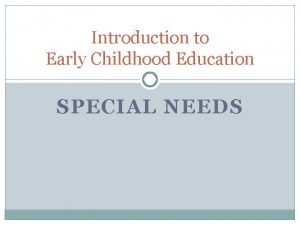Early Childhood Family Education Community Needs Assessment This













































- Slides: 45

Early Childhood Family Education Community Needs Assessment: This Year and Beyond MNAFEE, April 2015 Mike Brown, MDE “Leading for educational excellence and equity. Every day for every one. ”

Overview • What is a community needs assessment (CNA)? – Definitions – ECFE statutes – Why are we completing a CNA? • How does this fit in the broader picture? – Program – District – State • What is the process for completing the CNA? – Guidance documents and resources – Early childhood administration website • What are the requirements of future CNAs? education. state. mn. us 2

What is a Community Needs Assessment? • A community needs assessment identifies the strengths and resources available in the community to meet the needs of children, youth, and families. The assessment focuses on the capabilities of the community, including its citizens, agencies, and organizations. It provides a framework for developing and identifying services and solutions and building communities that support and nurture children and families. – from the U. S. Department of Health and Human Services education. state. mn. us 3

What is a Community Needs Assessment? • A community assessment may be limited to a compilation of demographic data from census records, results of surveys conducted by others, and informal feedback from community partners. • Or, assessments may be expanded to include focus group discussions, town meetings, interviews with stakeholders, and telephone or mailed surveys to partnership members and the community. education. state. mn. us 4

Why do a Community Needs Assessment? • Evaluate our programs to see if we are serving a representative sample of parents and families in our community, • Understand what issues may be impacting parents and families, • Learn what programming and services are most needed and wanted by parents and families, • Identify and learn about other programs and services for children and families, and • Gather data to enable us to track changes over time. education. state. mn. us 5

Why do a Community Needs Assessment? • Provide direction for programs, projects and activities, • Allow staff to determine priorities and allocate limited resources to activities that will have the greatest impact, • Create cohesion through the alignment of goals, strategies, professional development, and desired outcomes, and • Assist with continuous improvement activities by helping staff identify change, which instructional and other practices are working, and the strategies associated with the greatest success. (p. 3) education. state. mn. us 6

Needs Assessment Requirements New in the 2014 ECFE Statutes: ECFE programs must provide a community needs assessment that 1. identifies new and underserved populations, 2. identifies child and family risk factors, particularly those that impact children's learning and development, and 3. assesses family and parenting education needs in the community; education. state. mn. us 7

Tailored Programming and Services Early childhood family education programs must provide: • programming and services that are tailored to the needs of families and parents prioritized in the community needs assessment - 124 D. 13, Subd. 2, (7) education. state. mn. us 8

Flexibility Delivering Parent Education The program may provide parenting education programming or services to anyone identified in the community needs assessment. - 124 D. 13, Subd. 2, (a) education. state. mn. us 9

Process for Developing Guidance • Fit with Pre. K-3 rd Grade framework • Advisory group – Timeline and interpretation education. state. mn. us 10

Frameworks education. state. mn. us 11

Examples of Similarities between Frameworks • Frames the body of knowledge in the field of education. • Is applicable across the field of education with any type of education program, population, setting, and delivery mode. • Is a planning tool for the development of comprehensive approaches. • Shared visions, strategies, etc. • Coordinates/structures planning, implementation, evaluation education. state. mn. us 12

Framework Elements Cross-Sector Work Continuity and Pathways Parent Development Administrators Family Engagement Teachers Data-Driven Improvement Culture and Community Instructional Tools Family Development Parent-Child Relationships Early Childhood Development Learning Environment education. state. mn. us 13

PECCF Contribution to P 3 Framework Cross-Sector Work Continuity and Pathways Administrators Family Engagement Teachers Instructional Tools Data-Driven Improvement Learning Environment education. state. mn. us 14

Pre. K-3 rd Framework Implementation Scope Programs Grade Levels Schools Community education. state. mn. us 15

Your Approach Two main approaches to consider: – Limited – utilize demographic data from census records, relevant survey data, and informal feedback from community partners. – Expanded – include data from more assessments, including ones that you would conduct, like focus groups, interviews, surveys, etc. education. state. mn. us 16

Step One: Understanding Scope of CNA 1. Read through materials provided by MDE • Community Needs Assessment Guidance • Community Needs Assessment Worksheet 2. Visit EC Administration website to familiarize yourself with content of ECFE needs assessment page. http: //ecadmin. wikidot. com/ecfe-needs-assessment education. state. mn. us 17

Guidance Document 1. Determine focus 2. Determine plan for using CNA 3. Gather Information 1. Participation 2. Community 3. Children 4. Families 5. Services 4. Review and analyze 5. Make decisions and take action education. state. mn. us 18

education. state. mn. us 19

Potential Scope of CNA – Depth and Breadth ECFE Only Includes K-12 Meets minimum requirements 1 2 Other orgs/programs Contains Numerous Elements 3 4 5 Examples: 1 – This CNA is designed to address the three items listed in ECFE statutes. 3 – This CNA would include other needs assessment elements and be part of a larger process. For example, it might include surveys of parents and be part of a program’s ECFE enhancement process, or part of a broader K-12 effort. 5 – This CNA would include items in addition to above, and be part of a district or broader community needs assessment. education. state. mn. us 20

Initial Questions 1. What do you want to know and why do you want to know it? 2. What will be the scope of your CNA? 3. What is your timeline? 4. Who is planning the CNA and who is executing it? 5. How are you defining key terms? 6. Is your CNA part of a larger process? education. state. mn. us 21

What do you want to know and why do you want to know it? • Be intentional and strategic! • Consider your program goals, beliefs and mission statement. • Tie the information to your ECFE Program Enhancement Process and the ECFE Quality Indicators education. state. mn. us 22

What do you want to know and why do you want to know it? (sample) What we want to know: 1. Are we serving a representative sample of our population? 2. Have new families moved into our community? 3. What are child and family risk factors in our community? 4. What do parents want to know? How do we meet parents’ needs and wants? Why we want to know it: 1. To know if there are families we are not serving. 2. We need to reach out to build relationships. 3. We need to do a better job serving families with risk factors, including tailoring our programming and services to meet needs and wants of families. 4. We understand the needs of parents who attend our program, but we need to understand the needs and wants of all parents in our community. education. state. mn. us 23

How are you defining key terms? • Be specific, document terms. • For example, how are you defining community? – Albany school district may say that their community includes the residents of Albany, Albany township, Avon township, Farming township, St. Anthony, St. Martin and St. Martin township. education. state. mn. us 24

Step Two: Planning Complete Part II of the Community Needs Assessment Worksheet (questions 1 through 9) 1. Will your needs assessment include only the required components or will you be including additional components? 2. What is your timeline? 3. Do you think your needs assessment will use a limited, expanded or mixed method? (see page 1 of guidance document) education. state. mn. us 25

Step Two, cont. 4. Who is in charge of the CNA work? What are their responsibilities? 5. Who is helping with the CNA and what are their responsibilities? 6. Describe what you want to know and why you need to know it. 7. What key terms to you need to define? 8. If your CNA is part of a larger process, describe that process. 9. What data will you need to collect? education. state. mn. us 26

Step Three 1. Gather data education. state. mn. us 27

Step Three Gather Data on Participants • Who attends our program? Who seems to be most engaged in our program? Who attends an event or class but does not continue with program? • Are we providing targeted services where they are most needed? • Are we tailoring our classes and services to meet the needs of parents and families in our community? • How do parents and families experience our program (e. g. facilities, staff, classes, services, etc. )? education. state. mn. us 28

Step Three Gather Data on Community • Race/ethnicity of families and children • Numbers of children ages 0 -5 living in the community • Poverty rate for families • Child poverty rate • Number of single-parent households • Number of teenage parents • Number of immigrant families • Number of mothers in the labor force • Mobility rate for families in your community • Child health information • Child maltreatment rates education. state. mn. us 29

Step Three Gather Data on Children • Who are the children that struggle in our preschool, kindergarten, etc. ? • What puts a child “at-risk” in our community? • What do parents and families want for their children? • How does your organization determine how well children are doing? How do other organizations determine how well children are doing? education. state. mn. us 30

Step Three Gather Data on Families • Who are the families in our community? • What would help families in their role of educating and parenting? • What do parents want to know? What are the most common topics? • Where do families go for support and information? • What types of support and resources do families want/need? • What are the strengths of families in our community? education. state. mn. us 31

Step Three Gather Data on Services in the Community • Who else in your school district works with families? • Who works with children and families in our community? • What programs and services do parents and families access? education. state. mn. us 32

Step Four: Review and Analyze Data • Prioritize Needs • Root Cause Analysis • Identify Trends and Patterns • Summarize Findings Illustrate Your Story education. state. mn. us 33

education. state. mn. us 34

Step Five: Make Decisions and Take Action Examples: • Influence Your Programming and Services • Goals and Priorities • Influence your P-3 Plans and Work education. state. mn. us 35

Example #1 Step Two Jefferson ECFE (depth = 1; breadth = 1) • The Jefferson school district decided to focus on meeting the minimum requirements. • They want the needs assessment to be completed in time for state reporting. • They will use a limited method. • They assigned a parent educator to complete the CNA. • They plan on finding data that relates to the three require components. education. state. mn. us 36

Example #1 Steps Three and Four 1. Gather data • • • ECFE Participant Questionnaire data, district data from MDE (MN Report Card), and community data from Minnesota Compass. Established/known child and family risk factors. Parent education need data from parent educators. 2. Review and analyze data • • • Compared participant data with district and community data. Compared known child and family risk factors with district and community risk factors. Analyzed data from parent education topic finders. education. state. mn. us 37

Example #2: Step Four cont. 2. Review and analyze ECFE Participants District & Community Data Educational Level 31% HS and below 46% HS and below Household Income 40% Free and Reduced 56% Free and Reduced Hispanic or Latino 17% 31% Children w/ Spec Needs 4% 12% English Second Language 16% 19% 3. Make decisions and take action education. state. mn. us 38

Example #2 Step Two Montgomery ECFE (depth = 3; breadth = 3) • The Montgomery school district decided to focus on more than the minimum requirements. • They want the needs assessment to be completed in time for state reporting, but see this as ongoing. • They will use an expanded method. • They assigned a team of three to complete the CNA. • They plan on finding data that relates to the three require components in addition to data relevant to K. education. state. mn. us 39

Example #2 Step Three 1. Gather data In addition to the data collected by Jefferson, they also collected: • • • Survey data on parenting needs of parents of kindergarten aged children and parents who did not attend ECFE Survey data on parents of infants Information on children who were struggling in kindergarten. education. state. mn. us 40

Example #2 Step Four 1. Review and analyze data Similar to Jefferson, Montgomery: • Compared participant data with district and community data. • Compared known child and family risk factors with district and community risk factors. • Analyzed data from parent education topic finders. In addition, they analyzed: • Characteristics of children who were struggling in kindergarten. • What parents of infants and kindergartners were saying they needed/wanted. education. state. mn. us 41

Example #2 Step Four Make Decisions and Take Action Examples: • Influence Your Programming and Services – Created task force tasked with addressing needs of parents/families with infants • Goals and Priorities – Aligning programming and services, outreach to pregnant mothers, supporting parents through school transitions, outreach to families who do not enroll in ECFE or any kind of early learning program. • Influence P-3 Plans and Work – Created a parenting education transition program. education. state. mn. us 42

Data Reporting to MDE Program data submission requirements • Districts receiving early childhood family education revenue under section 124 D. 135 must submit annual program data, including data that demonstrates the program response to the community needs assessment, to the department by July 15 in the form and manner prescribed by the commissioner. - 124 D. 13, Subd. 13 education. state. mn. us 43

Data Reporting to MDE 1. How did you identify new and underserved populations? What were your key findings? 2. How did you identify child and family risk factors? What were your key findings? 3. How did you assess family and parenting education needs? What were your key findings? 4. How will your programming and services be tailored to the needs of families and parents prioritized in the community needs assessment? education. state. mn. us 44

Questions / Comments Mike Brown MDE mike. p. brown@state. mn. us education. state. mn. us
 Middle childhood is from
Middle childhood is from Ongoing assessment early childhood
Ongoing assessment early childhood Professional development program rockefeller college
Professional development program rockefeller college Early childhood education and care directorate
Early childhood education and care directorate Trends in early childhood education
Trends in early childhood education Early childhood education in pakistan
Early childhood education in pakistan Early childhood education in bangladesh
Early childhood education in bangladesh Pedagogical leadership in early childhood
Pedagogical leadership in early childhood Associates in early childhood education jobs
Associates in early childhood education jobs Early childhood education barbados
Early childhood education barbados Queen's university early childhood education
Queen's university early childhood education Connecticut early childhood education cabinet
Connecticut early childhood education cabinet Skinner's operant learning theory
Skinner's operant learning theory Holistic approach in early childhood education
Holistic approach in early childhood education Swot analysis early childhood education
Swot analysis early childhood education Ethical dilemmas in early childhood education
Ethical dilemmas in early childhood education Early childhood education
Early childhood education Bf skinner early childhood education
Bf skinner early childhood education Community needs assessment steps
Community needs assessment steps Pamela schwartz kaiser
Pamela schwartz kaiser Three types of early childhood programs
Three types of early childhood programs Types of early childhood programs chapter 2
Types of early childhood programs chapter 2 Nyc doe efq
Nyc doe efq Early childhood framework for quality
Early childhood framework for quality How to welcome parents in orientation
How to welcome parents in orientation Leonardo da vinci childhood
Leonardo da vinci childhood Fine motor skills development in early childhood
Fine motor skills development in early childhood Physical development in early childhood
Physical development in early childhood Early childhood research quarterly author guidelines
Early childhood research quarterly author guidelines Early childhood ireland garda vetting
Early childhood ireland garda vetting Psychosocial development in early childhood
Psychosocial development in early childhood Chapter 7 early childhood ages 3 through 5
Chapter 7 early childhood ages 3 through 5 Theories of child art development
Theories of child art development Amelia earhart early childhood
Amelia earhart early childhood Language development in early childhood
Language development in early childhood Prosposed
Prosposed Isaac newton early life and education
Isaac newton early life and education Eminem early childhood
Eminem early childhood A vygotskian classroom promotes ________.
A vygotskian classroom promotes ________. Bellfort ecc
Bellfort ecc Biosocial development in early childhood
Biosocial development in early childhood Brownsburg early childhood center
Brownsburg early childhood center Kentucky governor's office of early childhood
Kentucky governor's office of early childhood Minneapolis preschool screening instrument-revised (mpsi-r)
Minneapolis preschool screening instrument-revised (mpsi-r) Ldoe delivery recipes
Ldoe delivery recipes Smyth reflection
Smyth reflection

